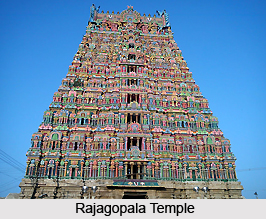 Temples of Tiruvarur district, in Tamil Nadu are some of the lovely constructions in south India. Tiruvarur District in Tamil Nadu is an agricultural land and presently a popular sacred destination of India. Amongst several temples of Tiruvarur district, Thyagaraja swami Temple happens to be the spot drawing the majority of crowd. It is the biggest chariot temple in Tamil Nadu and Tiruvarur is the birthplace of Sri Thyagaraja, one of the musical trinity of south India. The Mannargudi Rajagopalaswamy temple is another testimony to the fact that Tamil Nadu has been the foundation for all artistic works. Mannargudi temple is one among the temples of Tiruvarur district that was built in 1072 AD and the construction was completed after 50 years in 1122 AD.
Temples of Tiruvarur district, in Tamil Nadu are some of the lovely constructions in south India. Tiruvarur District in Tamil Nadu is an agricultural land and presently a popular sacred destination of India. Amongst several temples of Tiruvarur district, Thyagaraja swami Temple happens to be the spot drawing the majority of crowd. It is the biggest chariot temple in Tamil Nadu and Tiruvarur is the birthplace of Sri Thyagaraja, one of the musical trinity of south India. The Mannargudi Rajagopalaswamy temple is another testimony to the fact that Tamil Nadu has been the foundation for all artistic works. Mannargudi temple is one among the temples of Tiruvarur district that was built in 1072 AD and the construction was completed after 50 years in 1122 AD.
Some prominent temples of Tiruvarur district are Aabathasagawara Temple, Manaithunainathar Temple, Ratnagireeswarar-Manikkavannar Temple, Achaleswarar Temple, Mandrapureeswarar Temple, Sakala Bhuvaneswarar Temple and Agneeswarar Temple. Aabathasagawara Temple, also known as Guru Temple, is located at Alangudi, and is held sacred to Brahaspathi (Lord Guru). Also known as a Guru Sthalam, this temple enshrines Sri Aabathsagayeswara or Aranyeswara as the presiding deity is, a swayambhu Lingam. The goddess worshipped here is Umai Ammai or Elavarkuzhali. Sri Aabathsagayeswara is the lord of the Dhanu and Meenam rashis.
Aabathasagawara Temple is believed to be the 98th temple among the 127 temples located on the southern bank of Cauvery River and is also one among the 274 `Padal Petra Sthalams` in Chola Nadu. The temple has a separate sanctum that is dedicated to Lord Dakshinamurthy. It is believed that Sage Agastya and Adi Shankaracharya had worshipped Lord Guru in Alangudi. Another known temples of Tiruvarur district, includes the name of Mandrapureeswarar Temple, located at Tiruvusathanam. The temple is dedicated to Lord Shiva (Mandrapureeswarar). There is also a shrine for the Goddess Periyanayagi. The teertham of the temple is Vinmala. Sambandar is said to have sung pathigams, thus praising Mandrapureeswarar.
Sarpeswarar-Paampuranathar Temple is one of the important temples of Tiruvarur district and the famous Sarpeswarar-Paampuranathar Temple. The presiding deity is Lord Shiva, also known as Seshapureeswarar. The Goddess of the temple is Vandaar Poonkuzhali. Legends say that Sage Sambandar has sung hymns praising the lord. The main festivals celebrated in this temple of Tiruvarur district are Maasi Magam and Arudra Darisanam.
Jagadeeswarar Temple is one of the temples of Tiruvarur district and the temple deity is Lord Shiva in the form of Jagadeeswarar. Goddess Pennamizhdanayagi is also worshipped here. The temple teertham is known as Agni Teertham. Saint Sambandar has sung pathigams praising the lord Jagadeeswarar. Punnagavaneswarar-Bhramapureesar Temple, one of the temples of Tiruvarur district, is located at Ambar Maakalam near Tiruvarur. The temple is one of the 78 madakkovils constructed by Gochenkan Chola. The main deity of the temple is Lord Shiva known by the name Punnagavaneswarar. There is a separate chamber for Goddess Poonkuzhalammai.
Most of the temples of Tiruvarur district dates back to about 2000 years. These ancient temples have a glorious past and great architecture. Different sages and hermits are associated with the history of the temples of Tiruvarur district. Rajagopala Temple is located at Mannargudi and the temple complex with a 1000-year history and is considered the Dwaraka of the South. The main deity of this temple is the 7-ft tall Vasudeva and his consorts Sri Devi and Bhoodevi and the festival images of Sree Vidya Rajagopala, his consorts Rukmini and Satyabhama are also worshipped here. The deity Santanagopalakrishna here is believed to bless couples who are childless with progeny.
Apart from these temples of Tiruvarur district, there are others like Manikkavannal Temple, Naduthariyappar Temple, Sri Sarguneswaraswamy, Nartanapureeswarar-Aadal Vallavar Temple, Kaichinathar Temple, Neenerinathar Temple, Netrarpaneswarar-Veezhiazhageeswarar Temple, Tyagarajar Temple and Brahmapureesar Temple.





















